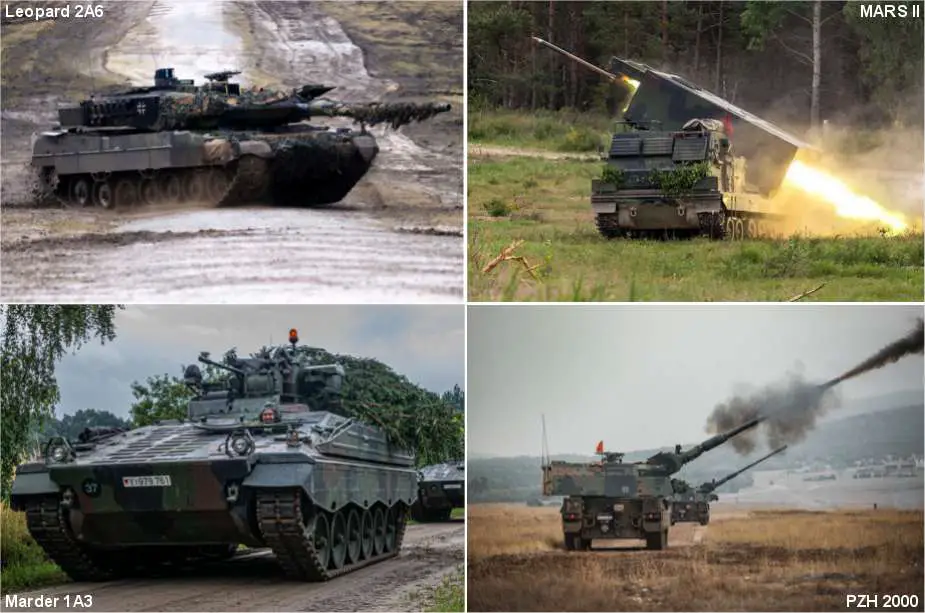Breaking news
Germany to provide €11 billion in military aid to Ukraine until 2028.
As of December 21, 2023, Germany continues to provide substantial support to Ukraine in its defensive efforts against Russia. Germany holds the position of being the largest European contributor and ranks as the world's second-largest contributor, following the United States, with nearly €6 billion dedicated to this cause. This support includes a wide range of material donations, logistical assistance, training programs, and cooperative initiatives.
Follow Army Recognition on Google News at this link

Since the start of the conflict, Germany has provided several armored vehicles, including Leopard 2A6 tanks, MARS II rocket launchers, Marder 1A3 IFVs, and PZH 2000 self-propelled howitzers. (Picture source: German MoD)
Since the start of the conflict, Germany has provided €5.97 billion to Ukraine, with an additional commitment of €4.929 billion extending until 2028, totaling nearly €11 billion. These funds, allocated from Section 60, have been distributed over several years. In 2022, Germany allocated €1.63 billion, supporting various initiatives, including the federal government's training initiative (EIBReg) and Ringtausch exchanges. In 2023, Germany allocated approximately €5.4 billion for military aid to Ukraine, representing a significant increase compared to 2022.
In terms of military vehicles, the German deliveries to Ukraine include various combat vehicles, such as tracked multipurpose vehicles (BV206, M113), infantry fighting vehicles (Marder 1A3), armored personnel carriers (Dingo 2), and main battle tanks (Leopard 1A5 and Leopard 2 A6).
In the air defense sector, Germany has supplied Ukraine with several air defense systems, including Gepard 1A2, Iris-T SLM and SLS, Patriot mobile air defense systems, and Stinger man-portable air defense systems (MANPADS). Artillery support encompasses 155mm munitions, multiple rocket launchers, including MARS II, and PZH 2000 self-propelled howitzers. Ukraine's engineering capabilities have been improved with Wisent 1 mine-clearing tanks, Biber bridge-laying tanks, Bergepanzer 2 and 3 recovery tanks, and Dachs 1A2 armored engineering vehicles (AEVs).
Additionally, Germany has provided various other types of combat equipment, including drones, weapons, laser rangefinders, and communication equipment. These efforts are complemented by logistical support, with numerous trucks and vehicles delivered to Ukraine, including specialized HMMWVs, Zetros, and HX81 heavy-duty trucks. The aid package also includes essential items like ammunition, medical supplies, and field equipment.
Germany's material deliveries to Ukraine primarily originate from Bundeswehr stocks and the German defense industry. Additionally, Germany initiated the Ringtausch program, commonly referred to as a 'circular exchange.' Under this initiative, Germany provides weaponry to re-equip allied countries, and in return, the recipient nation, acting as an intermediary, contributes a portion of its existing weaponry to Ukraine. This program aligns with Germany's efforts to encourage other nations to provide additional heavy weapons support to Ukraine. To further assist these countries, Germany also participates in covering a portion of the expenses for military purchases destined for Ukraine.
For instance, Germany engaged in a tank exchange with the Czech Republic, where 14 German Leopard 2A4s and a Bergepanzer 3 Büffel recovery vehicle were exchanged for at least 40 older Czech T-72 tanks destined for Ukraine.
Germany also played a role in the training sector, with more than 10,000 Ukrainian soldiers having received training in Germany, in collaboration with the Bundeswehr, 17 other nations, and industrial partners. These training courses cover various aspects, including tactics, battle management, vehicle operation, weapon systems, and their repair.
Finally, recognizing the importance of maintenance and repairs, Germany has established repair centers in cooperation with industrial partners located in Slovakia, Romania, and Lithuania. These centers aim to efficiently repair damaged or worn-out equipment, tailored to meet Ukrainian requirements.























